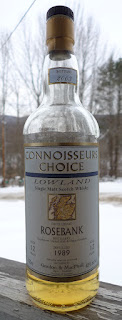stats: single malt scotch, Lowlands, 80 proof, $50
The Whisk(e)y industry is one of expansions and contractions, booms and busts. And with the long lead time between production and maturation, especially for Scotch whisky, forecasting future sales levels is a black art at best. With these two factors at work, it is no surprise that every once in a while a distillery will fall silent. During tough times some distilleries manage to get through by cutting production back to one or two days a week. Others cease operations entirely, sometimes just for a year or two, sometimes they are mothballed indefinitely, and occasionally they just close permanently.
When the stills go silent, whether it is an independent distillery that has gone out of business, or a single malt brand with weak sales which doesn’t fit into the portfolio of distilleries owned by a large conglomerate, there will usually be a significant quantity of aging spirit left in a warehouse – a valuable asset to be sold off over time. With the distillery closed, this product typically becomes the domain of blenders and independent bottlers. The independents will bottle it as single malt, and the legacy of a lost distillery can live on for several decades. Blenders will typically utilize the remnants of closed distilleries in one of two ways. Inferior barrels which aren’t up to snuff for bottling as single malt can be blended in with several hundred other barrels of whisky, cheap filler if you will (at least it doesn’t go to waste). The higher quality liquid can be used as a marketing tool to help top-shelf blends command greater prices. One example of this is the King George V version of Johnnie Walker Blue, which claims to contain some of the highly sought after Port Ellen malt, and fetches around $550 a bottle.
As the stocks of any brand dwindle over time, prices are certain to rise, but typically independent bottlings from closed distilleries fall into one of two camps: those that were highly regarded to begin with and whose loss was much bemoaned, and the lesser known brands that remain as more of a historical curiosity. The former will sell for top dollar, while the latter can represent tremendous values. Either way, selling a taste of liquid history is one of the independent bottlers’ greatest assets.
Many consider Rosebank to be the finest example of a Lowland malt, and it is one of the more sought after silent distilleries. But, probably due to the lack of interest in Lowland whiskies in general, there seems to be a good supply of Rosebank out there, and it can still be had for a reasonable price. Up until the distillery’s closure in 1993, Rosebank was produced in the Lowland tradition of triple distillation, a practice which has all but disappeared since.
Straw to very light amber in color, it is lightly fruity, with dry grass / grain on the mild nose. It’s kind of light and grassy on the palate, with a bit of malt to back it up. Not terribly complex, but it has some backbone and a respectable finish. This is fairly easy-drinking single malt, but still quite enjoyable.

No comments:
Post a Comment